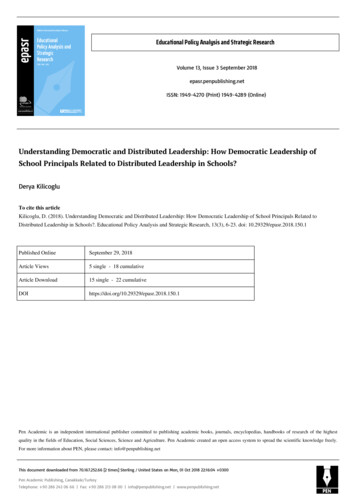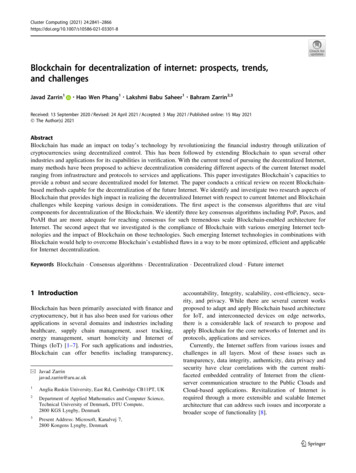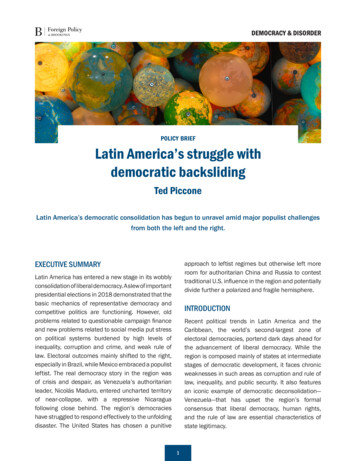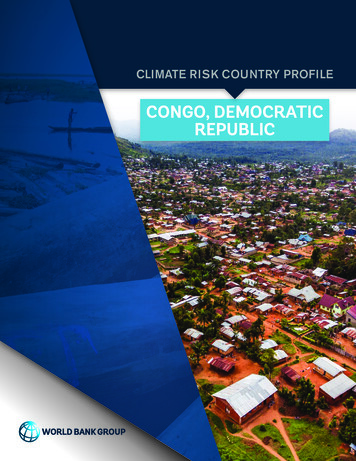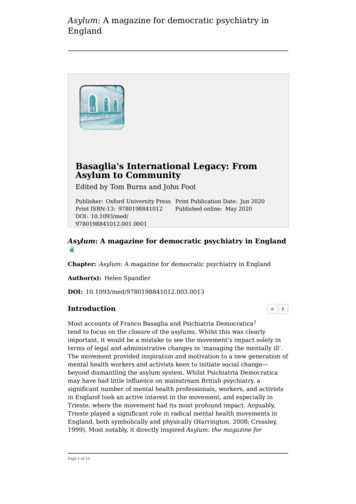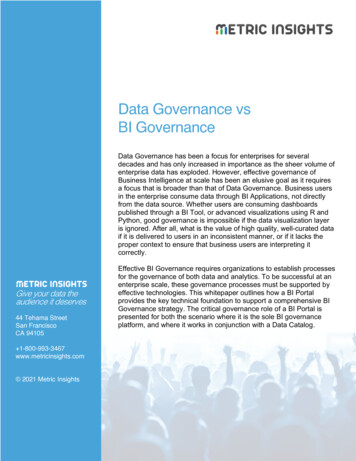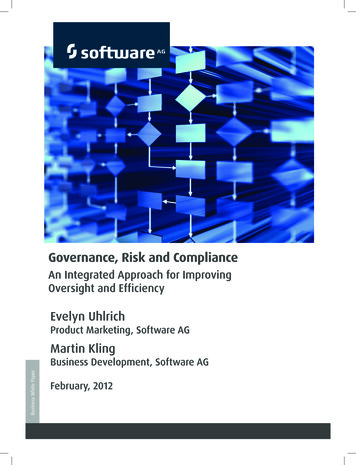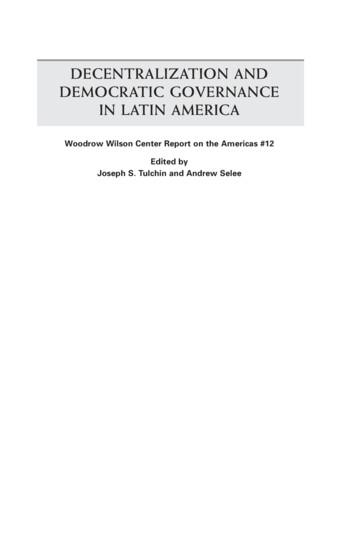
Transcription
DECENTRALIZATION ANDDEMOCRATIC GOVERNANCEIN LATIN AMERICAWoodrow Wilson Center Report on the Americas #12Edited byJoseph S. Tulchin and Andrew Selee
2004 Woodrow Wilson International Center for Scholars, Washington, D.C.www.wilsoncenter.org
Latin American ProgramDECENTRALIZATION ANDDEMOCRATIC GOVERNANCEIN LATIN AMERICAEdited byJoseph S. Tulchin and Andrew SeleeAdriana ClementeTulia FalettiRosa Amelia GonzálezLuis Felipe Linares LópezCarlos MascareñoMarcus MeloYemile MizrahiJesús Puente AlcarazFlavio RezendeLeticia Santín Del RíoCatalina Smulovitz
WOODROW WILSON INTERNATIONAL CENTER FOR SCHOLARSLEE H. HAMILTON, DIRECTORBOARD OF TRUSTEESJoseph B. Gildenhorn, Chair; David A. Metzner, Vice Chair. Public Members: James H. Billington,Librarian of Congress; John W. Carlin, Archivist of the United States; Bruce Cole, Chair, NationalEndowment for the Humanities; Roderick R. Paige, Secretary, U.S. Department of Education; ColinL. Powell, Secretary, U.S. Department of State; Lawrence M. Small, Secretary, SmithsonianInstitution; Tommy G. Thompson, Secretary, U.S. Department of Health and Human Services. PrivateCitizen Members: Joseph A. Cari, Jr., Carol Cartwright, Donald E. Garcia, Bruce S. Gelb, Daniel L.Lamaute, Tamala L. Longaberger, Thomas R. ReedyWILSON COUNCILBruce S. Gelb, President. Elias F. Aburdene, Charles S. Ackerman, B.B. Andersen, Russell Anmuth,Cyrus A. Ansary, Lawrence E. Bathgate II, Theresa Behrendt, John Beinecke, Joseph C. Bell, StevenAlan Bennett, Rudy Boschwitz, A. Oakley Brooks, Donald A. Brown, Melva Bucksbaum, Richard I.Burnham, Nicola L. Caiola, Mark Chandler, Peter B. Clark, Melvin Cohen, William T. Coleman, Jr.,David M. Crawford, Jr., Michael D. DiGiacomo, Beth Dozoretz, Elizabeth Dubin, F. Samuel Eberts III,I. Steven Edelson, Mark Epstein, Melvyn J. Estrin, Sim Farar, Susan R. Farber, Roger Felberbaum,Julie Finley, Joseph H. Flom, John H. Foster, Charles Fox, Barbara Hackman Franklin, NormanFreidkin, John H. French, II, Morton Funger, Gregory M. Gallo, Chris G. Gardiner, Gordon D. Giffin,Steven J. Gilbert, Alma Gildenhorn, David F. Girard-diCarlo, Michael B. Goldberg, Roy M. Goodman,Gretchen Meister Gorog, William E. Grayson, Ronald Greenberg, Raymond A. Guenter, Cheryl F.Halpern, Edward L. Hardin, Jr., John L. Howard, Darrell E. Issa, Jerry Jasinowski, Brenda LaGrangeJohnson, Shelly Kamins, James M. Kaufman, Edward W. Kelley, Jr., Anastasia D. Kelly, ChristopherJ. Kennan, Willem Kooyker, Steven Kotler, William H. Kremer, Raymond Learsy, Dennis A. LeVett,Francine Gordon Levinson, Harold O. Levy, Frederic V. Malek, David S. Mandel, John P. Manning,Jeffrey A. Marcus, John Mason, Jay Mazur, Robert McCarthy, Linda McCausland, Stephen G.McConahey, Donald F. McLellan, Charles McVean, J. Kenneth Menges, Jr., Kathryn Mosbacher,Jeremiah L. Murphy, Martha T. Muse, John E. Osborn, Paul Hae Park, Gerald L. Parsky, Jeanne L.Phillips, Michael J. Polenske, Donald Robert Quartel, Jr., J. John L. Richardson, Margaret MilnerRichardson, Larry D. Richman, Carlyn Ring, Edwin Robbins, Robert G. Rogers, Juan A. Sabater, AlanM. Schwartz, Timothy R. Scully, J. Michael Shepherd, George P. Shultz, Raja W. Sidawi, KennethSiegel, Ron Silver, William A. Slaughter, James H. Small, Shawn Smeallie, Gordon V. Smith, ThomasF. Stephenson, Norman Kline Tiefel, Mark C. Treanor, Anthony G. Viscogliosi, Christine M. Warnke,Ruth Westheimer, Pete Wilson, Deborah Wince-Smith, Herbert S. Winokur, Jr., Paul Martin Wolff,Joseph Zappala, Richard S. Ziman, Nancy M. ZirkinABOUT THE CENTERThe Center is the living memorial of the United States of America to the nation’s twenty-eighthpresident, Woodrow Wilson. Congress established the Woodrow Wilson Center in 1968 as aninternational institute for advanced study, “symbolizing and strengthening the fruitful relationship between the world of learning and the world of public affairs.” The Center opened in 1970under its own board of trustees.In all its activities the Woodrow Wilson Center is a nonprofit, nonpartisan organization, supported financially by annual appropriations from Congress, and by the contributions of foundations, corporations, and individuals. Conclusions or opinions expressed in Center publicationsand programs are those of the authors and speakers and do not necessarily reflect the views ofthe Center staff, fellows, trustees, advisory groups, or any individuals or organizations that provide financial support to the Center. iv
TABLE OF CONTENTSPrefaceJoseph S.Tulchin1Chapter 1Exploring the Link between Decentralization andDemocratic GovernanceAndrew Selee3Chapter 2Decentralization and Governance in BrazilMarcus Melo and Flavio Rezende37Chapter 3Federalism and Decentralization in Argentina: HistoricalBackground and New Intergovernmental RelationsTulia Faletti67Chapter 4Decentralization and Social Expenditure at theMunicipal Level In ArgentinaCatalina Smulovitz and Adriana Clemente101Chapter 5Mexico: Decentralization From AboveYemile Mizrahi137Chapter 6Decentralization and Democratic Governance in MexicoLeticia Santín Del Río167 v
Chapter 7Decentralization And The Restructuring Of PoliticsIn VenezuelaRosa Amelia González And Carlos Mascareño187Chapter 8A General View Of The Institutional State OfDecentralization In GuatemalaJesús Puente Alcaraz and Luis Felipe Linares López231Contributors275 vi
PREFACEJOSEPH S. TULCHINIn the last decade, in every part of the world, there has been anunprecedented swing to democratic forms of government. In LatinAmerica, this shift has been accompanied by macroeconomic reformsthat have given priority to market forces. While the nature or strength ofthese democratic regimes has been the subject of intense and protracteddebate, most analysts agree that, whatever their definition of democracyor their appraisal of the quality of existing democratic regimes, there is“more” democracy today than there was ten or twenty years ago.In the present volume, we explore one of the crucial intersections ofpolitical and economic change: how the reform of the central state in theform of policies of decentralization has affected democratic governance indifferent countries and at different levels of society. More specifically, weexamine the impact of decentralization on civil society and how civilsociety and the state interact in decentralized democratic governance. Webelieve that the success or failure of the relationship between civil societyand the state at subnational levels will be central to the construction ofdemocratic governance in Latin America in the coming decades.This book is the product of a two-year project on decentralization atthe Woodrow Wilson Center, generously supported by the TinkerFoundation, which included both national-level and comparative researchon decentralization. Two scholars from each of the five countries involved(Argentina, Brazil, Venezuela, Guatemala, and Mexico) met inWashington at the outset of the project to present papers on decentralization and discuss the various experiences of their countries comparatively.Each of the national research teams, together with the Wilson Center,then organized a national forum on decentralization and democratic governance that included scholars; national, regional, and local governmentofficials; civil society representatives; and, in several cases, representativesof the business community. Publications were produced with summariesof the debate in each of these fora. In light of these debates and the com 1
Joseph S. Tulchinparative discussion among the research team, the participating researchersrevised their chapters for this volume.We hope that this volume will make a contribution to the importantdebate on decentralization and democratic governance in Latin Americaand to broader debates on state reform in the region. 2
CHAPTER ONEExploring the Link Between Decentralizationand Democratic GovernanceANDREW SELEEIn the 1980s and 1990s, decentralization reforms swept across LatinAmerica as almost every country implemented measures to strengthenthe role of local and regional governments.1 This was hardly an isolated trend, however. Countries as distinct as South Africa, France, and thePhilippines underwent similar processes during this period. According toone estimate, 63 out of the 75 countries with a population over 5 millionhave undergone a major process of decentralization since 1980.2Proponents of decentralization in Latin America and elsewhere, who havebeen drawn from all places on the ideological spectrum, have argued thatstrengthening local and regional governments would both improve theefficiency of government and contribute to better democratic governance. In this book we look at the second proposition to see how decentralization has affected democratic governance in five Latin Americancountries: Mexico, Guatemala, Venezuela, Brazil, and Argentina.Decentralization is not new in Latin America. Most countries in theregion have a dual legacy of centralized political institutions inheritedfrom Spanish colonial rule and strong regional identities and interestsenhanced by the weakness of the post-colonial state. However, throughout the twentieth century the central state in almost all of Latin Americasucceeded in concentrating an unprecedented degree of power, authority,and resources under its control. This concentration of power succeeded incounteracting the centrigual influences of regional elites and helped setthe bases for some degree of state-led development in the region.However, authoritarian and exclusionary3 regimes in most countries alsoused this concentration of power to limit or silence the voice of citizens.In Michael Mann’s terms, the state exercised its centralized power primarily through coercion of civil society rather than developing an institu 3
Andrew Seleetionalized power that could coordinate the activities of civil society productively.4As many of these countries underwent transitions to elected governments in the 1980s and 1990s, decentralization became a favorite strategyof democratic reformers who wanted to ensure that the central statewould not have the overbearing power that it had possessed—and political leaders abused—in previous decades. According to many partisans ofthis approach, decentralization would make the state more accessible toaverage citizens and ensure a counterweight to the abuse of power bynational leaders. At the same time, many political leaders, facing the economic crises of the 1980s and 1990s, hoped that decentralization wouldhelp make the state more efficient by generating government servicesmore in line with citizens’ demands and willingness to pay.The chapters in this book look at how decentralization has affecteddemocratic governance by assessing two dimensions of decentralization.First, we ask how much decentralization has redistributed power within thestate by actually giving local and regional governments increased authority, power, and resources. Second, we ask how much has decentralizationredistributed power between the state and citizens, in order to create a moreresponsive and accountable state.We find that the answers to both questions are mixed. All of the countries studied have undergone important processes of decentralization thatappear to have transformed the role of local and regional governments.However, we find that the depth of decentralization is strongly correlatedwith previous processes of decentralization, so that countries with longerhistories of centralization have remained, de facto, largely centralized evenafter formal attempts to change this. Moreover, the effect of decentralization on democratic governance is uneven. On one hand, decentralizationhas broadened spaces of electoral competition and generated importantexperiences of democratic innovation in many subnational governments.On the other hand, in other subnational areas, it has reinforced andrevived authoritarian regional and local power structures that centralizedgovernment had been designed to control. This analysis forces us to lookat the uneven tapestry of state-society relations in each of the countries.These findings suggest that the success of decentralization, like manyother important initiatives of state reform that have been designed toimprove the performance and responsiveness of the state in Latin 4
The Link between Decentralization and Democratic GovernanceAmerica, cannot be viewed outside the historical and political context inwhich it is implemented.CENTRALIZATIONINLATIN AMERICAN HISTORYCentralization in Latin America has a long historical legacy dating back tothe Spanish and Portuguese conquest of the Americas. The colonial systems implanted by the Spanish and Portuguese in their New Worldcolonies were based on extraction of wealth and required a strongly centralized set of institutions to coordinate this process. These centralizedinstitutions have formed the basis of post-colonial governance systemsthat continue to this day (Véliz 1980), although in many cases they weremodified by the adoption of French-inspired models of centralist administration during the post-independence period.However, the colonial legacy of Latin America also created a countervailing force to centralism in the form of regional elites who had economic and political dominance over specific territorial extensions andpopular movements that contested the terms of citizens’ inclusion withinthe nation-state. After independence, regional elites became increasinglyimportant, given the weakness of the post-colonial state, and most countries became a patchwork of loosely held together regions. The history ofcentralization in Latin America is therefore also tied to a struggle betweennational and regional elites in the process of state formation and conditioned by popular struggles over meaning and political participation.Emerging national elites gradually sought to centralize power in the capital as a means of dominating large concentrations of rule-making authority outside of the state (Midgal 1988). While Latin American statesretained a symbiotic relationship with regional elites, they gained certainrelative autonomy vis-à-vis these elites during the course of the 20th century by centralizing power further.Two of the countries in this volume, Brazil and Argentina, are federalstates with a long history of highly decentralized government, althoughthey have oscillated between periods of greater and lesser centralization.Argentina began as a loosely organized confederation of provinces and thecity of Buenos Aires after independence. It was not until 1860s - and morestrongly after 1880 - that the modern state began to emerge with the creation of a federal government with some degree of authority over the 5
Andrew Seleeprovinces and port city. The provinces retained a fair degree of power overthe federation, but this was slowly eroded in the era of mass parties in thetwentieth century as successive presidents strengthened the autonomy ofthe federation against the provinces. Several periods of military rule furthercentralized power in the federation, as Falleti observes in chapter 3.Melo and Rezende (chapter 2) argue that Brazil began as a highly centralized empire, although with significant regional centers of poweramong large landholders in the states. After the beginning of the firstrepublic in 1890 it became a federal state with considerably decentralizedloci of power. The 1930s ushered in the period of the developmentaliststate with the rule of President Vargas, and this began a long period ofcentralization of power in the federal government under the belief that astrong national state was necessary for development. The period of military dictatorship from 1964 to 1985 further centralized power in the federation. However, regional elites retained their power bases and emergedfrom the military regime as significant political actors (Hagopian 1996).Two other countries examined in this volume, Venezuela and Mexico,are also federal states but they have historically been quite centralized,more so even than many unitary states in the region. Venezuela’s processof re-centralization began in the late 19th century, but increased dramatically during the administration of President Juan Vicente Gomez (190435). The advent of oil extraction gave the federation resources beginningin the 1920s that were used to further develop the autonomy of the statevis-à-vis regional elites (Levine and Crisp 1999; Kornblith and Levine1995). The emergence of mass-based parties in the 1940s, and the powersharing agreement between the two major parties in 1958, cemented apolitical system in which allegiance to the party was primary over regional bases of power. This “partyarchy” cemented a highly centralized system,with the parties monopolizing power and most space for civil society(Coppege 1994).Mexico became highly centralized under the administration ofPresident Porfirio Díaz in the late 19th and early 20th century, but theMexican Revolution of 1910-20 led to the almost complete collapse ofthe state. After the Revolution, President Plutarco Elias Calles createdwhat would come to be called the Revolutionary Institutional Party(PRI) as an all-encompassing party that would seek to include all majorinterests in society and serve as a mechanism for mediating conflicts 6
The Link between Decentralization and Democratic Governanceamong competing forces (Mizrahi, chapter 5). As the PRI strengthenedits role as the ruling party, regional elites were increasingly moved amongpositions in the political system, increasing their allegiance to the partyover their original power bases (Cornelius 1999; Tulchin and Selee 2003).The party never succeeded entirely in eradicating local power bosses,however, and these have remained until today in several regions of thecountry (Díaz Cayeros 1995). At the same time, indigenous identitieswere gradually suppressed in the attempt to forge a single national identity, and the state used a mixture of force and co-optation in an attempt tocontrol and assimilate indigenous communities (Mallon 1992, Rus 1994,Díaz Polanco 1997). However, the Mexican corporatist state was never asall-encompassing and monolithic as often portrayed. Local political struggles, cultural meanings, and forms of social organization shaped the formsof political incorporation of communities and regions throughoutMexico. These showed considerable variation depending on particularlocal histories and patterns of state-society relations (Joseph and Nugent1994, Vaughan 1999, Rubin 1997).The remaining country, Guatemala, is a unitary state, and has a longhistory of centralized government, albeit in considerable symbiosis withregional elites. Linares and Puente in chapter 8 note that like most of itsneighbors in Central America, Guatemala endured long periods of military dictatorship, a total of 78 years in the twentieth century. The periodof the late 1970s and early 1980s brought an especially harsh period ofmilitary rule that further centralized power through military and paramilitary control of the countryside. As in Mexico, the state also sought tocontrol the majority indigenous population through a mixture of repression and co-option of indigenous leadership. The Guatemalan state managed to impose military control over its territory, but it largely failed todevelop a strong institutional base that could penetrate society by nonmilitary means (Smith 1990, 13-14).This quick review—developed more fully by each of the chapterauthors—suggests that by the early 1980s most Latin American states haddeveloped a highly centralized institutional structure and a degree of relative autonomy from regional elites, but that these states were far frommonolithic institutions of political power. On one hand, centralizationcontributed to the period of remarkable state-led growth from the 1940sthrough the early 1970s in the region and succeeded in reinforcing a 7
Andrew Seleestrong sense of national identity in most countries. On the other hand,centralization in the context of authoritarianism also helped to suppressdissent, distort policymaking priorities, and limit the expression of ethnicidentities.5 Moreover, centralization also left a harsh legacy for equity inmost of the countries. Indeed, it should be noted that public investmentswere usually concentrated in the capital and major cities.6 Even underelected governments, voices for regional development and advocates ofthe poorest sectors of society were routinely marginalized from decisionmaking processes.THE ORIGINSOFDECENTRALIZATIONIn the 1980s and 1990s, decentralization reforms swept through LatinAmerica, driven by both economic and political considerations. Thesevere economic crises that struck all the countries in the region in theearly 1980s caused a crisis of legitimacy for state elites. The reduction ofgovernment budgets further eroded traditional clientelistic arrangementsthrough which politicians maintained their links to voters. At the sametime, significant civic movements around democracy, human rights,indigenous rights, and economic justice had been building in the 1970sand early 1980s and important international regimes had developedaround these issues (Chalmers et al. 1999, Levine and Crisp 1999, 40811). These movements brought new demands into the public sphere andenergized challenges to existing political arrangements (Avritzer 2002,Oxhorn forthcoming) In this context, state elites often seized on decentralization as a means of redirecting discontent to local arenas or recovering citizens’ confidence in the political system. While these efforts weresometimes aimed at preventing major political changes, they generatedsignificant political upheavals in all of the countries studied.In Venezuela, the delegitimization of the two-party system in the middle of the economic crisis led to the appointment of the PresidentialCommission on State Reform in 1984, made up of political, church,business, and civic leaders. The Commission’s report in favor of constitutional reforms, the pressure of civil society organizations, and the explosion of popular discontent at the end of the decade led to the creation ofelected state and municipal governments for the first time in 1989(Mascareño and Gonzalez, chapter 7; Levine and Crisp 1999, 408-11). 8
The Link between Decentralization and Democratic GovernanceIn Mexico, the 1982 peso devaluation and ensuing depression led thefederal government, anxious over citizen discontent, to implement amunicipal reform in 1983 that granted municipalities greater autonomywith new functions and resources. The PRI-led governments of the1980s and 1990s implemented a series of additional reforms expandingstate and municipal functions and increasing resources to subnational governments in response to repeated crises of political legitimacy and thedemands of an ever-growing opposition. Mizrahi (chapter 5) argues thatthe PRI gradually allowed the opposition to win spaces at a local level inorder to deflect conflict away from national-level politics, but the increasing local success of the opposition parties helped gradually dislodge thePRI from power. At the same time, successive governments pursued sectoral decentralization in health and education in the belief that this wouldmake services more efficient and demand-driven.In Guatemala, both national leaders’ search for legitimacy and the peaceprocess with the armed insurgency of the URNG propelled the process ofdecentralization, according to Linares and Puente (chapter 8). The 1984constituent assembly was a first step for the country emerging from theperiod of extreme violence in the early 1980s, and led to the 1985 constitution that granted substantially increased authority to municipal governments (while keeping departmental governments as appointed bodies).Constitutional changes in the 1994, as part of the growing process ofdemocratization and resolution of the civil war, further deepened thedegree of decentralization. The peace accords with the URNG, signed in1996, added a series of provisions that granted recognition to indigenousforms of association and dispute resolution within municipalities, althoughthese provisions were only approved as law in 2002 (Cardona 2002).Transitions to democracy in Brazil and Argentina restored the historically important role of state and provincial governments, respectively, inthe 1980s. Municipal governments also gained a degree of autonomy,although this was significantly less than that of the regional level. In Brazil,the economic crisis speeded the return to democracy after two decades ofmilitary dictatorship. The newly elected government convened a constitutional convention to set the outlines of the new democratic regime.Melo and Rezende (chapter 2) argue that the centralized government wasseen as a legacy of the discredited military governments and that politicalforces from left to right promoted decentralization as a means of ensuring 9
Andrew Seleetransparency, participation, and equity. The decentralized nature of political parties, which in Brazil have traditionally been controlled by localelites (Mainwaring 1995), also made decentralization a key theme formost of the political parties involved in the debates of the constitutionalconvention, which included decentralization reforms in the 1989 constitution (Willis, Garman, and Haggard 1999).In Argentina, the provinces recovered authority with the return todemocracy and increased their margin of influence through iterativenegotiations with the national executive throughout the 1980s (Willis,Garman, and Haggard 1999). The arrival of a Peronist president in 1990,who had run on a banner of federalism, coupled with a severe fiscal crisisled the central government to transfer major responsibilities and resourcesto the provinces in the early 1990s. The Argentine government decentralized both education and healthcare to the provinces without accompanying resources to compensate them for the new responsibilities, accordingto Falleti (chapter 6). This helped the federal government achieve its goalsof reducing the federal budget, but left the provinces in a precariousfinancial situation.Initial decisions to decentralize were mostly top-down in the five countries. In Brazil and Argentina, where there was a history of decentralizationand political parties were considerably more decentralized, subnationalactors had a much greater influence on the process (Willis, Garman, andHaggard 1999). However, for the most part, initial decisions to strengthenthe political role of subnational governments have been driven by nationalleaders’ desire to reinforce or regain legitimacy in the eyes of the populace,with the desire to deepen democracy a secondary concern. Decisions onsectoral decentralization, primarily education and health, on the other hand,have been driven by concerns for efficiency or fiscal pressures. Althoughboth of these processes were largely top-down, decentralization inevitablycreates new stakeholders, especially subnational government officials, whobecome important actors in later negotiations over the terms of decentralized governance. Attempts to reverse decentralization reforms inArgentina, Brazil, and Venezuela, for example, have all met with substantial resistance from local and regional government leaders (Eaton 2001;Melo and Rezende, chapter 2; Bland 2002c).Nonetheless, it is worth noting that governors and mayors, despitetheir role in resisting re-centralization, have not emerged as strong, 10
The Link between Decentralization and Democratic Governanceunequivocal champions of decentralization either. In each of the countries studied, mayors’ and governors’ associations remain relatively weakand often divided along partisan lines. In Mexico, for example, there aremayors’ associations for each of the three major parties (Santín, chapter 6),although a tenuous national alliance of the three associations has emergedrecently. The National Governors’ association is also primarily led by theopposition governors, with sporadic participation by those affiliated withthe governing party. In Guatemala, the mayors’ association has onlyrecently begun to emerge from the shadow of the Interior Ministry anddevelop its own platform (Linares and Puente, chapter 8). In Argentina,governors are largely split along party lines, although there are some signsthat they have begun to work together more closely on education policy(Falleti 2002). Overall, concerns shared by leaders of subnational governments tend to remain highly subordinated to partisan concerns.REDISTRIBUTING POWER WITHIN THE STATE?How much has decentralization effectively redistributed power amonglevels of government in Latin America? To assess this, we need to understand the way that decentralization reforms have reshaped state functionsalong three key dimensions of decentralization: political, administrative,and fiscal (Rondinelli 1981).Political DecentralizationPerhaps the most striking element of decentralization in Latin Americahas been the emergence of elected governments at a regional and locallevel (Chart 1.1). At the beginning of the 1980s, few Latin Americancountries had local authorities chosen in free and fair elections. This mirrored and compounded the lack of democracy at a national level in mostcountries. With the return to democratic rule in Argentina and Brazil in1983 and 1985 respectively, governments were once again elected forprovinces/states and for municipalities, after a long period in which fewelections had taken place.7 In Venezuela, where no elected offices existedat the state or municipal level, constitutional changes allowed full elections for municipal governments starting in 1985 and for state governments starting in 1989. In Mexico, elections had taken place regularly formayors and state governors since the 1917 constitution, but no opposition 11
Andrew S
DECENTRALIZATION AND DEMOCRATIC GOVERNANCE IN LATIN AMERICA Edited by Joseph S. Tulchin and Andrew Selee Adriana Clemente Tulia Faletti Rosa Amelia González
